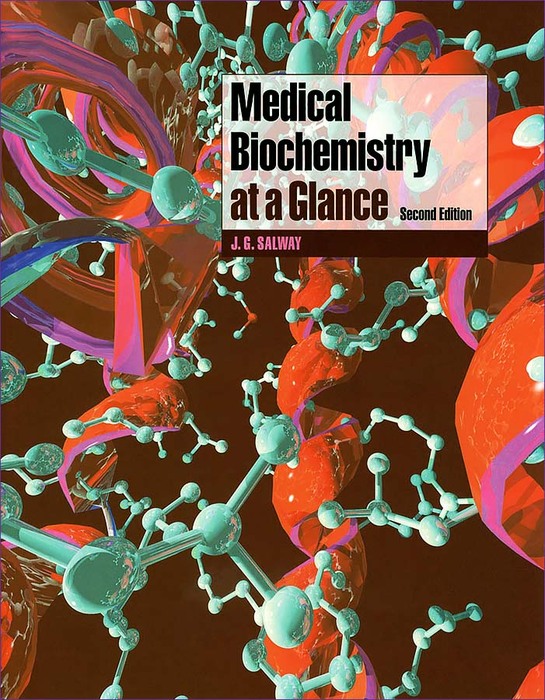Medical Biochemistry at a Glance 2/e 2006
定價
$ 650
售價
$ 400
數量:
Medical Biochemistry at a Glance 2/e 2006-需求單
內容簡介
Medical Biochemistry at a Glance provides a concise and accessible introduction to this complex subject and a revision aid for medical students. Following the familiar, easy-to-use at a Glance format, each topic is presented as a double-page spread with key facts accompanied by clear tables and diagrams encapsulating all the students need to know.
This new edition of Medical Biochemistry at a Glance:
• Has been completely re-organised, revised and updated
• Is written by the author of the hugely successful Metabolism at a Glance
• Contains a second colour throughout to enhance the visual appeal, making the subject even easier to understand
• Presents line drawings and biochemical pathways on the left page and concise explanations of the right, providing a user-friendly overview of medical biochemistry
• Condenses medical biochemistry into 60 digestible double-page spreads
Medical Biochemistry at a Glance will appeal to medical students in the early years of their course, and those revising for final exams. The book is also suitable for biological science and biochemistry students.
作者簡介
Dr Jack Salway– School of Biological Sciences, University of Surrey.
目次
1. Acids, bases and hydrogen ions (protons).
2. Understanding pH.
3. Production and removal of protons into and from the blood.
4. Metabolic alkalosis and metabolic acidosis.
5. Respiratory alkalosis and respiratory acidosis.
6. Amino acids and the primary structure of proteins.
7. Secondary structure of proteins.
8. Tertiary and quaternary structures and collagen.
9. Enzymes: nomenclature, kinetics and inhibitors.
10. Regulation of enzyme activity.
11. Carbohydrates.
12. Absorption of carbohydrates and metabolism of galactose.
13. Oxidation/reduction reactions, coenzymes and prosthetic groups.
14. Anaerobic production of ATP by substrate-level phosphorylation, phosphocreatine and adenylate kinase reaction.
15. Aerobic production of ATP.
16. Biosynthesis of ATP by oxidative phosphorylation I.
17. Biosynthesis of ATP by oxidative phosphorylation II.
18. What happens when protons or electrons leak from the respiratory chain?.
19. Free radicals, reactive oxygen species and oxidative damage.
20. Aerobic oxidation of glucose to provide energy as ATP.
21. Anaerobic oxidation of glucose by glycolysis to form ATP and lactate.
22. Anaerobic glycolysis in red blood cells, 2,3-BPG and the Bohr effect.
23. The fate of glucose in liver: glycogenesis and lipogenesis.
24. Fructose metabolism.
25. Glucose homeostasis.
26. Glucose-stimulated secretion of insulin from b-cells.
27. Regulation of glycogen metabolism.
28. Glycogen breakdown (glycogenolysis) and glycogen storage diseases.
29. Insulin signal transduction and diabetes mellitus.
30. Regulation of glycolysis and Krebs cycle.
31. Oxidation of fatty acids to produce ATP in muscle and ketone bodies in liver.
32. Regulation of lipolysis, b-oxidation, ketogenesis and gluconeogenesis.
33. Diabetes mellitus.
34. Alcohol metabolism: hypoglycaemia, hyperlactataemia and steatosis.
35. Structure of lipids.
36. Phospholipids I: phospholipids and sphingolipids.
37. Phospholipids II: micelles, liposomes, lipoproteins and membranes.
38. Metabolism of carbohydrate and fat to cholesterol 86.
39. VLDL and LDL metabolism ("forward" cholesterol transport).
40. VLDL and LDL metabolism (endogenous triacylglycerol transport).
41. HDL metabolism ("reverse" cholesterol transport).
42. Absorption and disposal of dietary triacylglycerol, and cholesterol by chylomicrons.
43. Steroid hormones: aldosterone, cortisol, androgens and oestrogens.
44. Urea cycle and overview of amino acid catabolism.
45. Non-essential and essential amino acids.
46. Amino acid metabolism: to energy as ATP; to glucose and ketone bodies.
47. Amino acid disorders: maple syrup urine disease, homocystinuria, cystinuria, alkaptonuria and albinism.
48. Phenylalanine and tyrosine metabolism in health and disease.
49. The products of tryptophan and histidine metabolism.
50. Pyrimidine metabolism.
51. Purine metabolism.
52. Haem, bilirubin and porphyria.
53. Fat-soluble vitamins I: vitamins A and D.
54. Fat-soluble vitamins II: vitamins E and K.
55. Water-soluble vitamins I: thiamin, ribofl avin, niacin and pantothenate.
56. Water-soluble vitamins II: pyridoxal phosphate (B6).
57. Water-soluble vitamins III: folate and vitamin B12.
58. Water-soluble vitamins IV: biotin and vitamin C.
59. Diagnostic clinical chemistry.
Index
ISBN-13碼 :
9781405113229
ISBN-10碼 :
1405113227
出版日期 :
2006
版次 :
2
書系代碼 :
04182
作者 :
J. G. Salway
開數 :
菊8開
頁數 :
152
裝訂 :
平裝
定價 :
NT$650.00

